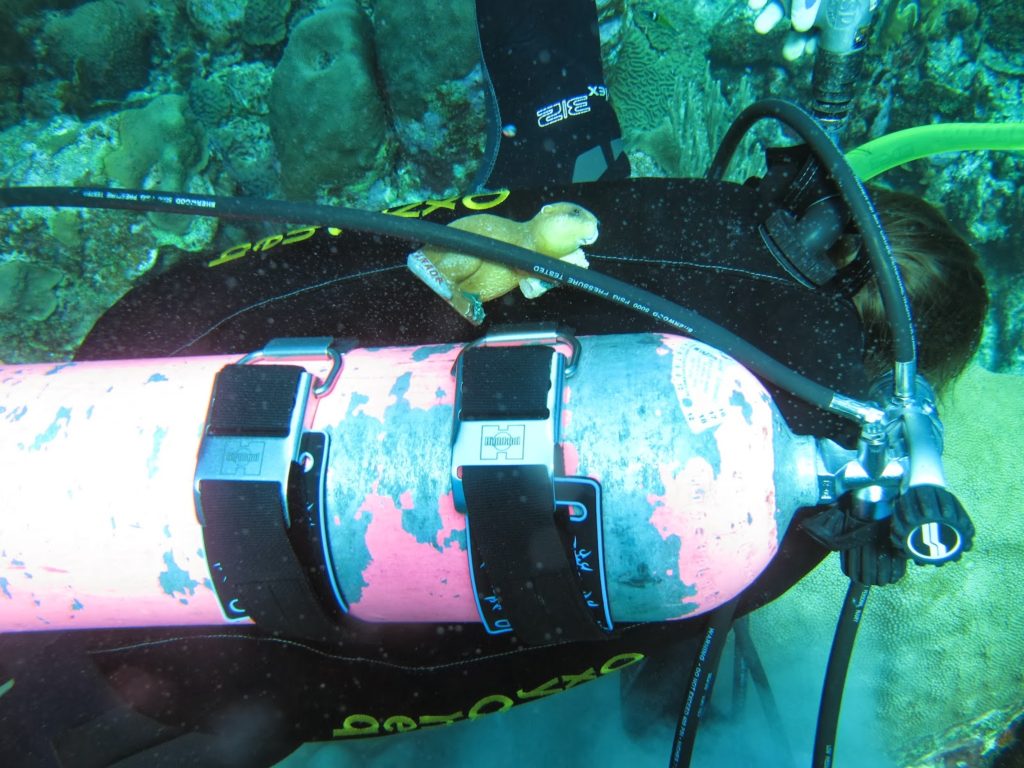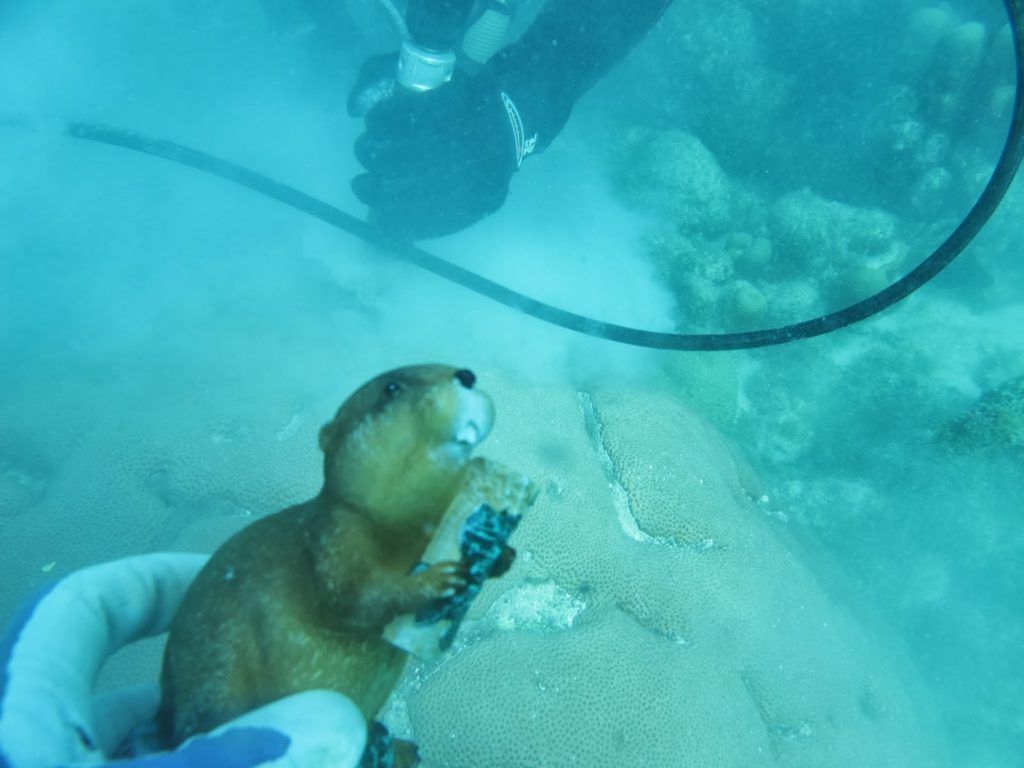In addition to our science team and crew, there is a special inhabitant of Sea Dragon. His name is Sir Archibald Munchingham, a cunning and amusing little fellow who came aboard as stowaway near Niagara Falls during Sea Dragon’s last transit in Canadian waters. Known as nature’s engineer, Archibald’s company during our trip as been extremely fortuitous as the beaver is also MIT’s mascot, and as coral researchers, we study a special type of marine engineer.

Archibald’s thirst for adventure and mischief has kept us on our toes during our voyage for he often appears in unexpected places or is found scurrying among the deck or through our food stocks. His most recent hiding place was inside our bread maker, no doubt trying to gather the last crumbs from Alice’s latest creation. As we prepared for our last set of dives on the lovely island of Curacao, Archibald nuzzled up and asked if he could come along to explore the wonders of the sea. Naturally, we agreed, and so began Archibald’s first scuba diving voyage to core corals. We’ll let him take it from here…
I had heard so much about the ocean from friends that I was anxious to finally experience this majestic landscape for myself. The team of scientists we currently have on board certainly seem to like swimming in it a lot, for every morning they awake bright and early and after a scrumptious breakfast – of which of I usually get a yummy side plate – are off carrying and moving all sort of heavy cylinders and funny looking jackets with hoses that dangle everywhere (I think I heard one of the deck hands call it SCUBA gear). I finally worked up the courage to ask them if I could come along and see what all the fanfare was about and was thrilled when they agreed.
I was carefully placed in a Ziploc baggie and attached to an even larger bag that had a whole array of long tubes in it and which, judging from the looks of the young man carrying it, was rather heavy – I hope it wasn’t from my eating so many pancakes that morning… A short but bouncy dinghy ride later all the clattering of tanks around me told me we had arrived at the “dive spot.” I was beside myself with joy and sneaked a tiny nibble at my enclosure. I was then plunged into the water, cool and refreshing, though salty, very salty – certainly not as pleasant to drink as the crisp river waters I’m accustomed to.
The ocean was just as I had always hoped, magnificently beautiful and busy with tiny little fish darting every which way. There were also large colorful rocks that appeared to have tiny circles and tentacles protruding from the surface. I believe these might be the famous “corals” team science had discussed at length most evenings over dinner. My bag landed softly on a sand patch, and I watched as the divers began to assemble the tubes that accompanied me into a long rod that was then attached to what looked like a silver pistol.

They placed the rod atop of a big coral rock and it began to spin, as it let out a shrill shriek that made me jump with surprise. There was plume of white powder that surrounded the spinning drill as the divers pushed down on the handle and began to core. I watched the operation with a mixture of awe and curiosity, trying to determine what the scientists were doing as they removed white cylinders of coral from the colony and added more rods to their drill.
About halfway through, the scientist, Tom came over and asked if I wanted a closer look. I nodded furiously while I held on tightly to the little log that I always carry with me. I scurried up his hand and he swam me over to the action. Up close, I could tell this was no easy task. The other diver, Alice, was grasping a nearby rock tightly while she pushed with the other arm on the drill handle and pressed the trigger. I asked if I could try my hand at this drilling business and Alice swam aside to give me the seat of honor. I grabbed the drill bit and braced myself. I pressed the trigger with all my might, but it only barely budged. The scuba tank that powers it was out of air.
Luckily, one of the other science members was at the surface ready with a new tank, which sank gracefully into Alice’s hands as she let the empty one go and it rushed to the surface, where it was quickly recovered by our snorkel support. Once recharged, I pressed the trigger again and the bit whirled away. But oh boy! It was so tough to keep it going for a tiny little beaver like me! After a minute or two, I decided I had had enough and let Alice continue with her work. Tom, continued his tour and showed me how they tag the corals they drill with a bright yellow tag so they can return to it in the future and showed me gleaming white logs that are the coral cores. Once the core was finished, I helped the team inspect the drill hole to make sure everything was out and then we patched it up nicely with an epoxy plug. Despite the invasive operation to the colony looked no worse for wear. I then spent a few minutes exploring the reef as the scientists gathered all their gear.
I swam in and around sea fans and coral rubble, following tiny bright fish that looked confused upon seeing me. I suppose they had never seen a beaver before. I quickly made friends with a tiny blue fish with electric blue spots and a vivid yellow tail. She said she was a damselfish and showed me to a small patch of algae that was apparently her garden. As I watched her trim away at fluffy leaves that swayed rhythmically with the waves, a large fish swam by and hovered over us.
“Hello, Mr. Blowfish how are you this morning?” said the damsel.
“Quite well, thanks. Though I was awakened by the most odd noise. Did you hear it earlier? It was a very shrill sound, and when I poked my head out of my cave I saw a slew of bubbles of some very oddly shaped… seals, perhaps? hovering over some coral. Any idea what that was?” replied he.
“I can tell you, Sir,” I interrupted. “Those were my friends whom you saw. They are human scientists, not seals. The sounds were from the drill they were using to core the coral so that they could study how natural climate changes have affected coral health,” I continued.
“Fascinating!” exclaimed the Blowfish and the Damselfish, “It has been getting mighty hot around here these days,” they added in agreement.
After a few more minutes of dialogue, my tour guide came to fetch me to return to the surface. I said goodbye to my new friends, while they insisted I come again some day. Back on the boat I ran around excitedly telling the rest of the crew about my new found friends and ocean adventure. It was one for the books (or at least the blogs).
– Hanny Rivera (and Archibald the Beaver)
To see a video follow the link to the Caribbean Coral Blog:
http://caribbeancorals.blogspot.com/2013/12/archibald-beaver-dives-with-cohen-lab.html





















